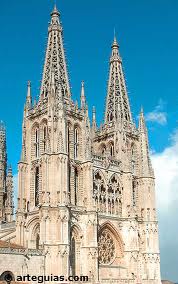High Gothic Architecture
Gothic architecture spread across Europe with the same ease and speed as the Romanesque style had done in the previous two centuries. While there certainly are greater differences among the regional forms of Gothic aesthetic in the continent than there had been in relation to the previous dominant artistic trend, there still remain clearly visible common characteristics that could be said to abound through the range of Gothic styles.

Indeed, three of these novel features could be identified as defining the constructions erected during the period known as High Gothic: the use of rib vaults on roofs and aisles; the preference of pointed arches above semicircular arches in general, but specifically in the fashioning of windows; and the use of flying buttresses to anchor the buildings.
Aesthetically the three characteristics are closely connected to each other, and it is quite likely that their development was the consequence of the same search for engineering solutions. Indeed, one major plus derived from the use of rib vaults was the reduction of construction costs, as Gothic architecture could now dispense of thick, solid walls, in favour of far leaner structures with large openings.
The first move in the direction of the rib vault was to cross to traditional barrel vaults and get a double barrel vault. This progression carried all the weight of the construction from the walls to the columns that held the vaults. But the arrises that were formed from crossing two semicircular vaults were geometrically complicated and often required much work.
In came the rib vault, whose pointed arch allowed for far more flexibility in the erection of tall buildings. But once the semicircle was broken (a pointed arch is just a section of a larger semicircle) there was no need to use it in the rest of the construction, either: tall windows peaked with pointed arches replaced the formerly austere openings of the Romanesque architecture.
These two elements gave specific characteristics to the architecture of the High Gothic that certainly defined the style: it enabled builders to reach higher, solving many of the issues of illumination inside the temples and giving the structures an altogether more ephemeral feel. This, too, was mirrored in the buttressing of the higher buildings, which would now carry the outward weight of the vaulted roofs through flying buttresses to outer walls of buttresses.
The effect of these developments is absolutely remarkable, as can be seen in some of the greatest examples of Gothic architecture in Spain: the Cathedrals of Burgos and León. Both of them are based on the structure of the Cathedral of Reims, and therefore evidence a strong French influence in the style prevalent in Spain at the time.

Started in 1221, Burgos Cathedral was constructed over a staggering three centuries, which explains why the final product is lacking in uniformity. Nevertheless, all of the elements described above can be clearly seen in the building as it exists today, with pointed arches dominating its western facade all the way up the towers, rib vaults cutting across its aisles and flying buttresses supporting the higher levels of the nave.
Similarly, León offers one of the most breathtaking samples of the High Gothic style in the country, with a more uniform style than Burgos and with the added value of an unparalleled collection of medieval stained glass decorating the myriad windows along the nave of the cathedral.
Which takes us to an additional dimension in Gothic architecture: the decoration. Much more boisterous than the earlier Romanesque, High Gothic style uses stained glass and sculpture both to spread the message, to recreate allegorical readings as well as to divulge the Marian rite, so important in the Cistercian tradition, and simply to enhance the beauty and effect of buildings, through gargoyles or saints.
In this respect, should you go on holiday in Madrid you cannot miss the opportunity to take the short ride to Toledo and appreciate the High Gothic tradition of Spain in full in the grandiose splaendour of its cathedral.
